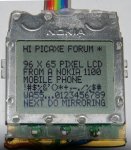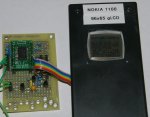westaust55
Moderator
There have been several threads detailing use of the Nokia 3310 and equivalent LCD modules as gLCD displays.
I have even run a thread on the Siemens A55 LCD module.
The Nokia 3310 and equivalents have an 84 x 48 resolution.
The Siemens A55 and equivalents have a 102 x 64 resolution
Now I have a Nokia 1100 mobile/cell phone.
Looking at the available information, the basic specs are:
Resolution: 95 x 65
Driver chip: PCF8814 chip -- http://www.datasheets.org.uk/PCF8814*-datasheet.html
Driver chip interface: has 3-wire serial, SPI and i2c
Logic Supply: 1.7 to 3.3 Volts
Backlight: inbuilt LED
Easy to solder connections: http://sunbizhosting.co.uk/~spiral/secret files/1100lcd.html
Unfortunately it seems the Nokia connections do not use the i2c interface
so will progress based on the "usual" SPI type serial interface.
May be a while before I actually get around to assembling a demo project for this particular LCD module
At this time though that others may be interested from the viewpoint that
- it has a better resolution than the 3310 series 84x48 displays
- a check on Ebay finds more available that the 3310's
- has an inbuilt backlight through the main LCD connector
I have even run a thread on the Siemens A55 LCD module.
The Nokia 3310 and equivalents have an 84 x 48 resolution.
The Siemens A55 and equivalents have a 102 x 64 resolution
Now I have a Nokia 1100 mobile/cell phone.
Looking at the available information, the basic specs are:
Resolution: 95 x 65
Driver chip: PCF8814 chip -- http://www.datasheets.org.uk/PCF8814*-datasheet.html
Driver chip interface: has 3-wire serial, SPI and i2c
Logic Supply: 1.7 to 3.3 Volts
Backlight: inbuilt LED
Easy to solder connections: http://sunbizhosting.co.uk/~spiral/secret files/1100lcd.html
Unfortunately it seems the Nokia connections do not use the i2c interface
so will progress based on the "usual" SPI type serial interface.
May be a while before I actually get around to assembling a demo project for this particular LCD module
At this time though that others may be interested from the viewpoint that
- it has a better resolution than the 3310 series 84x48 displays
- a check on Ebay finds more available that the 3310's
- has an inbuilt backlight through the main LCD connector
Last edited:





